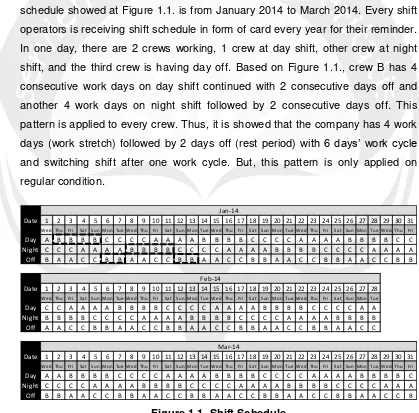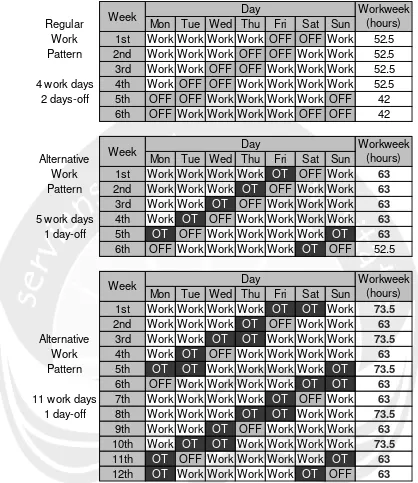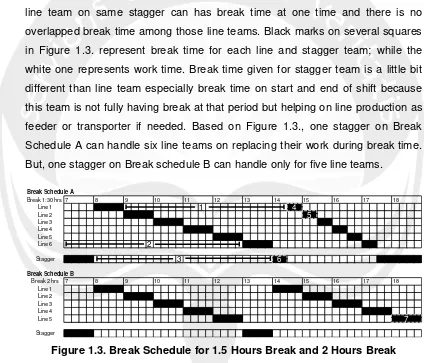1
CHAPTER 1
INTRODUCTION
1.1. Background
One of hard disk drive manufacturer which has factory sites in Thailand is
applying 24 hours per day and 7 days per week production with 12 hours for each
shift. As the duration for one shift is 12 hours, there are two different shifts; day
and night shift. Working hour for each shift is from 7 a.m. to 7 p.m. for day shift,
and 7 p.m. to 7 a.m. for night shift. The shift operators in production line are all
women which grouped into 3 crews; crew A, B, and C. The example of shift
schedule for those 3 crews in regular work can be seen in Figure 1.1. Shift
schedule showed at Figure 1.1. is from January 2014 to March 2014. Every shift
operators is receiving shift schedule in form of card every year for their reminder.
In one day, there are 2 crews working, 1 crew at day shift, other crew at night
shift, and the third crew is having day off. Based on Figure 1.1., crew B has 4
consecutive work days on day shift continued with 2 consecutive days off and
another 4 work days on night shift followed by 2 consecutive days off. This
pattern is applied to every crew. Thus, it is showed that the company has 4 work
days (work stretch) followed by 2 days off (rest period) with 6 days’ work cycle
and switching shift after one work cycle. But, this pattern is only applied on
regular condition.
Date 1 2 3 4 5 6 7 8 9 10 11 12 13 14 15 16 17 18 19 20 21 22 23 24 25 26 27 28 29 30 31
Wed Thu Fri Sat Sun Mon Tue Wed Thu Fri Sat Sun Mon Tue Wed Thu Fri Sat Sun Mon Tue Wed Thu Fri Sat Sun Mon Tue Wed Thu Fri
Day A B B B B C C C C A A A A B B B B C C C C A A A A B B B B C C
Night C C C A A A A B B B B C C C C A A A A B B B B C C C C A A A A
Off B A A C C B B A A C C B B A A C C B B A A C C B B A A C C B B
Date 1 2 3 4 5 6 7 8 9 10 11 12 13 14 15 16 17 18 19 20 21 22 23 24 25 26 27 28
Wed Thu Fri Sat Sun Mon Tue Wed Thu Fri Sat Sun Mon Tue Wed Thu Fri Sat Sun Mon Tue Wed Thu Fri Sat Sun Mon Tue
Day C C A A A A B B B B C C C C A A A A B B B B C C C C A A
Night B B B B C C C C A A A A B B B B C C C C A A A A B B B B
Off A A C C B B A A C C B B A A C C B B A A C C B B A A C C
Date 1 2 3 4 5 6 7 8 9 10 11 12 13 14 15 16 17 18 19 20 21 22 23 24 25 26 27 28 29 30 31
Wed Thu Fri Sat Sun Mon Tue Wed Thu Fri Sat Sun Mon Tue Wed Thu Fri Sat Sun Mon Tue Wed Thu Fri Sat Sun Mon Tue Wed Thu Fri
Day A A B B B B C C C C A A A A B B B B C C C C A A A A B B B B C
Night C C C C A A A A B B B B C C C C A A A A B B B B C C C C A A A
Off B B A A C C B B A A C C B B A A C C B B A A C C B B A A C C B
Jan-14
[image:1.595.93.512.289.702.2]Mar-14 Feb-14
2
Once the demand increases and cannot be fulfilled by regular work pattern, it will
change into 4 days regular work, 1 day overtime, and 1 day-off (5-1 work
pattern); or 8 days regular work, 3 days overtime, and 1 day-off (11-1 work
pattern) as the worst case. The illustration of current work pattern and other
options of work pattern can be seen in Figure 1.2. Currently, total break time on
one shift is 1.5 hours or 90 minutes. Therefore, each employee works for 10.5
hours each day which got from 12 hours shift duration deducted by total break
time in one shift. When there is overtime, the employees will work as long as
regular work. Showed in Figure 1.2., there are 4 elements considered on work
pattern; work, OT, OFF, and workweek. The combination between work, OT
(overtime), and OFF based on work pattern are repeated continuously without
considering week change. Total week displayed in work pattern depends on the
pattern for next week. If the pattern for next week is same with pattern on first
week, work pattern will not display work pattern for next week. Therefore, there
are 6 weeks on current work pattern and alternative 5-1 work pattern, and 12
weeks on alternative 11-1 work pattern. The first day of work on each work
pattern assumes to start on Monday. Workweek is total working hours including
overtime in one week. This value is calculated on each week in work pattern. This
value is also the critical point on creating work pattern because its value must not
exceed the regulation. The regulations are given by EICC and Apple. Apple as
one of the company’s customer publishes Apple Supplier Code of Conduct for its
supplier. Moreover, this company and Apple are joined in an organization named
EICC (Electronic Industry Citizenship Coalition) that publishes EICC Code of
Conduct to be applied by the members and its supply chain. Thus, this company
must follow those two regulations which stated that workweek should not be more
than 60 hours per week, including overtime (EICC, 2014; Apple, 2013). When the
value of workweek is greater than 60 hours, it is highlighted by bold font. The
result shows that only workweek for regular work pattern and the sixth week on
alternative 5-1 work pattern has fulfilled EICC’s and Apple’s regulation.
Unfortunately, this company is currently applying alternative 5-1 work pattern
which most of its workweek exceed the regulation. This problem is categorized as
tour scheduling because it is combination of day off scheduling by assigning work
day and off day in certain period and shift scheduling by assigning the crews
3
Regular Mon Tue Wed Thu Fri Sat Sun
Work 1st Work Work Work Work OFF OFF Work 52.5
Pattern 2nd Work Work Work OFF OFF Work Work 52.5
3rd Work Work OFF OFF Work Work Work 52.5
4 work days 4th Work OFF OFF Work Work Work Work 52.5
2 days-off 5th OFF OFF Work Work Work Work OFF 42
6th OFF Work Work Work Work OFF OFF 42
Alternative Mon Tue Wed Thu Fri Sat Sun
Work 1st Work Work Work Work OT OFF Work 63
Pattern 2nd Work Work Work OT OFF Work Work 63
3rd Work Work OT OFF Work Work Work 63
5 work days 4th Work OT OFF Work Work Work Work 63
1 day-off 5th OT OFF Work Work Work Work OT 63
6th OFF Work Work Work Work OT OFF 52.5
Mon Tue Wed Thu Fri Sat Sun
1st Work Work Work Work OT OT Work 73.5
2nd Work Work Work OT OFF Work Work 63
Alternative 3rd Work Work OT OT Work Work Work 73.5
Work 4th Work OT OFF Work Work Work Work 63
Pattern 5th OT OT Work Work Work Work OT 73.5
6th OFF Work Work Work Work OT OT 63
11 work days 7th Work Work Work Work OT OFF Work 63
1 day-off 8th Work Work Work OT OT Work Work 73.5
9th Work Work OT OFF Work Work Work 63
10th Work OT OT Work Work Work Work 73.5
11th OT OFF Work Work Work Work OT 63
12th OT Work Work Work Work OT OFF 63
Week Day Workweek
(hours) Workweek
(hours) Day
Week
Week Day Workweek
[image:3.595.91.509.84.567.2](hours)
Figure 1.2. Work Pattern
In a smaller scope, one day work can be break down into break schedule for one
shift. This company gives two times break for shift workers. As explained before,
this company currently gives 1.5 hours break or 90 minutes, with 1 hour on the
first break and 30 minutes on the second break which can be seen on Break
Schedule A in Figure 1.3. In other hand, Break Schedule B showed in Figure 1.3.
is proposed break schedule from IE (Industrial Engineering) Department with 2
hours break with 1 hour each respectively. But due to many things should be
4
understood on break schedule is the header which represents working hour for
one shift. Based on Figure 1.3., the header shows starting time from 07:00 to
18:00 with each column represents one hour. Each header has 4 squares below
which represent 15 minutes each. This company has two different kinds of team
in the production floor named as regular team and stagger team. Every worker on
regular team is grouped based on line of production. Stagger team is responsible
to replace one line’s work during break time to have continuous production.
Therefore, operators as stagger team can do any operations needed to cover
during their shift. A group of lines and stagger team which work on the same shift
schedule is called as crew. The break time’s policy in this company is only one
line team on same stagger can has break time at one time and there is no
overlapped break time among those line teams. Black marks on several squares
in Figure 1.3. represent break time for each line and stagger team; while the
white one represents work time. Break time given for stagger team is a little bit
different than line team especially break time on start and end of shift because
this team is not fully having break at that period but helping on line production as
feeder or transporter if needed. Based on Figure 1.3., one stagger on Break
Schedule A can handle six line teams on replacing their work during break time.
But, one stagger on Break schedule B can handle only for five line teams.
Break Schedule A Break 1:30 hrs
Line 1 Line 2 Line 3 Line 4 Line 5 Line 6 Stagger
Break Schedule B Break 2 hrs
Line 1 Line 2 Line 3 Line 4 Line 5 Stagger
17 18
7 8 9 10 11 12 13 14 15 16 17 18
12 13 14 15 16
[image:4.595.88.512.269.632.2]7 8 9 10 11
Figure 1.3. Break Schedule for 1.5 Hours Break and 2 Hours Break
Considering on working hours for workers, Thailand’s Ministry of Labour (1998) is stated that consecutive work hours should not be more than five hours followed
by one hour break. Unfortunately, some parts on Break Schedule A violate the
regulation. Those parts are highlighted by numbers in Figure 1.3. Working
duration on number 1, 2, and 3 are greater than 5 hours, and break time on
number 4, 5, and 6 are less than 1 hour. In addition, Break Schedule B assigns
1 4
5
2
6 3
5
the last line team to have break time on the end of shift which is highlighted by
number 7 in Figure 1.3. This condition should be eliminated because the
operators are cannot going home earlier while the others are still working in
production line. Therefore, both Break Schedule A and Break Schedule B are
needed to be revised. As the problem appeared in break schedule is how to
assign break time on shift, it is categorized as break scheduling problem.
In summary, there are two problems appeared in this company; tour scheduling
and break scheduling. To find out the contribution of this research, previous
researches are reviewed but not only limited on tour scheduling problem but also
day off scheduling, shift scheduling and break scheduling problem. On shift
scheduling problem, Rekik et al. (2010) have considered multiple breaks by
giving 3 sub breaks on 9 hours’ shift work with forward and backward constraint and implicit model. On day-off scheduling problem, Alfares has solved 5 work
days and 2 off days scheduling problem by implementing dual linear
programming (Alfares, 2001); 14 work days and 7 off days scheduling problem by
utilizing dual solution and primary-dual relationship (Alfares, 2002), and 3 work
days and 4 off days scheduling problem by implementing integer programming
(Alfares, 2006). Elshafei and Alfares (2008) also give contribution on solving
single shift day-off scheduling problem with sequence dependent labor cost; 3
work days and minimum 2 off days by implementing dynamic programming
algorithm. On cyclic scheduling problem, Kaluzny and Hill (2011) have developed
shift schedule for officers which work for 4 days and rest for 2 days with 8 to 12
hours work per shift by applying split and stitch method and generating integer
linear programming model. Yuniartha (2012) also has developed shift pattern for
Front Office staffs which work with 3 types of shift and work for 5 days following
with 1 off day. Another literatures from Brusco and Jacobs (2000) had solved
continuous tour scheduling problem with 9 hours work per shift and have cyclic
work pattern of 5 days’ work and 2 days off by implementing GSCF (generalized
set-covering formulations) and implicit programming. Laporte and Pesant (2004)
also has done research about cyclic scheduling by developing Constraint
Programming (CP) for multi-shift rotating schedules with 3 types of shift on one
day and can be applied on any types of work pattern. Brunner et al. (2009) also
have developed shift construction on scheduling the physicians which work for 7
hour to 13 hours with one hour break per shift and 42 hours to 54 hours in total
6
Based on all the previous references, there is previous research considering
multiple breaks and other researches considering work pattern and shift type, but
there is no research has considered combination between those two
components. Therefore, contribution of this research is application of tour
scheduling which is combining between work pattern and shift type and
application of break scheduling for multiple breaks in one shift.
1.2. Problem Formulation
Based on the research background described above, then the problems in this
research can be stated as: “Consecutive work hours of shift workers is more than
five hours which violates Thailand’s Ministry of Labor law; and the total working
hours per week for shift workers is more than sixty hours which violates EICC
and Apple Supplier Code of Conduct”.
1.3. Research Objectives
The objective of this research is proposing new break schedule to fulfill
Thailand’s Ministry of Labor law and work pattern to fulfill Apple and EICC Compliance by creating program on Microsoft Excel.
1.4. Scope and Limitation
The scope and limitation of this research are:
1. This research only focuses on shift workers in production line
2. This research is considering two breaks in one shift
3. Shift types in this research are day shift and night shift
4. Shift length in this research is 12 hours per shift
5. There are three crews assigned in this research
6. Number of headcount is not considered in this research


